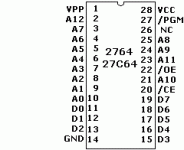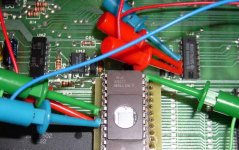giobbi
Veteran Member
The address lines are confusing, but let's start with the D4 data line. It is stuck low while the others are pulsing. Check all the many places D4 connects for solder splashes or shorting.
Dave, sorry for that, but either I don't understand or I'm missing something. You told the D4 line, but afaik it's the eprom pin 16, and it's pulsing (all the data lines are pulsing).
As quick reference:
--Giovi
---------------------------------------------------------------------------------------------------------------------------------
p.s. [OT] - I'm in trouble with the damn'd pet too, so if you would to take a look to my other thread, it would make my day better ;-)
p.p.s. yes, I know, I'm a pest :D
Last edited:


